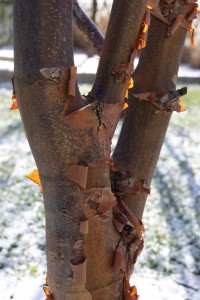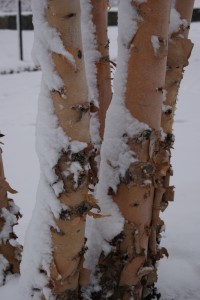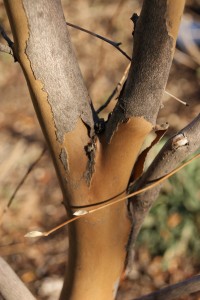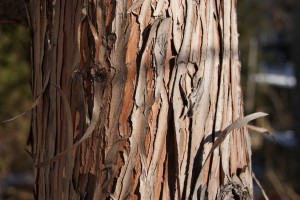Oh! That Exfoliating Bark!
Oh that exfoliating bark! Winter interest continued.
Whether it is dry, cold, bright and sunny or gray, muted, frosty and snowy, the bark on the trees can’t help itself. It stands out in the sparseness of winter, and the best bark of all is the exfoliating bark. It’s rolled, peeling, curled edges; it’s patterned blotches and abstract shapes, it’s subtle and still contrasting colors – all these attributes make it interesting and curious.
Exfoliating bark is peeling bark. This is the way nature designed these trees – as the tree grows in size and diameter the bark is shed, curling away from the trunk and eventually falling off as the newer layers grow underneath. Along the way the tree is shedding itself of possible infecting funguses, scale insects and egg masses from potentially harmful pests. During a brisk jaunt out on the Greenway this morning I was able to find 7 different species of these trees, all in about 15 minutes!
Most people will be familiar with white trunked birch trees, a native whose bark has traditionally been used for paper, baskets, clothing and canoes. Betulas nigra ‘Cully’ is the River Birch we have in the Wharf district. The other peeling bark varieties we have tend toward ornamental, non-native trees. Stewardia pseudocamellia and Acer griseum are two smaller trees that are wonderful, unusual additions to home yards. The Japanese Stewartia has everything except fragrance – flowers, fun bark, nice shape, great fall color. The Paperbark Maple has it’s lustrous bronze to orange peeling bark to seduce you. Seeing it back lit in a grove is better than cathedral stained glass but it lacks a nice shape and any show of flowers. The other exfoliating bark trees will eventually grow much larger, and so take more consideration before planting around your house.
The native Juniperous virginiana, our common red cedar, the wonderful deciduous conifer Taxodium distichum, or Baldcypress , Platanus x acerifolia the London Planetree and the Chinese Elm Ulmas parviflora ‘Dynasty’ are all other trees with exfoliating bark that live along the Greenway. There are many other species to explore and consider – hopefully we have sparked your interest in a winter walk and some further investigation on your own.




